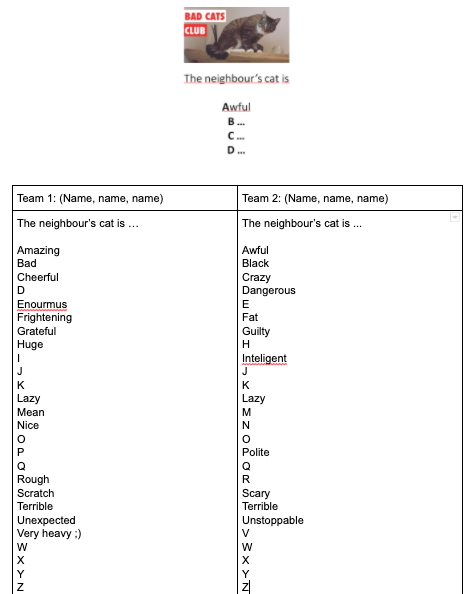At my school, as with many schools around the world, we have had to move all of our teaching online very quickly. As I write this, it’s not even one month since we all became Zoom beginners, but even so our teachers have experimented with all kinds of activities. Here are some tried and tested activities that have worked with our teenage classes at International House Bydgoszcz, Poland:
Finding common ground
Social distancing is hard for most people and especially so for secondary-aged learners, who are used to seeing their friends every day at school. It’s easy for us all to feel like we’re alone in our situation – but we’re not. By changing the type of activity I use as warmers, my students have realised that they’re all in this together, they can still have social interactions and a couple of them have even found a new gaming buddy!
It started with ways they could remain physically active. Before the lesson I created a Google doc with a heading and a simple table. At the start of the lesson I shared the link with my students and gave them editing privileges. Writing one idea per square, the students shared ways they’d remained physically active so far during quarantine. I started asking questions and soon they too were asking each other questions. From that simple activity, a couple of students discovered new YouTube channels to follow, they all laughed at my shock that they’d been given PE homework, two of them started gaming together (exercise for your fingers) and they all started the lesson engaged, smiling and working as a group.
Since then, we’ve had: pranks to play in your family, ways to use English for authentic purposes during quarantine (they literally wrote their own holiday homework) and ‘the most annoying thing my siblings / parents have done’. This change in the aims of the warmer activity completely changed the students’ engagement, both with the online lesson and with each other.
Ruth Walpole, Assistant Director of Studies
Getting creative
For the online lesson, I created a series of slides with a double page spread inspired by a children’s book on each slide (conveniently, it was one page of text and one picture). I made my own model page on slide 2.
The main aim was to create a short story, using the pictures as inspiration for the story. In addition to this, I told students that there had to be at least one passive sentence on each slide (we had focused on passives in the previous lesson so this was good revision). The other challenge was to make sure they were using a range of tenses, since we’ve recently worked with past perfect and reviewed past simple and past continuous.
There were two groups and I gave each group their own link to separate presentations. Both documents had the same slides; this allowed them to work in isolation from the other group. The groups had edit access and wrote their stories directly on the slides.
For feedback, I sent the other group’s link to everyone and let them read the other group’s story, comparing the content and seeing what language points they missed and had in common. It worked quite well and took about 30-35 minutes, but it was time well spent!
Ash Simpson, Teacher
Updating a classic
I tried out the activity ‘My neighbour’s cat’ from page 54-56 of Ur and Wright’s Five-Minute Activities. I created a Google Doc with two columns, one for each team. The columns already had the alphabet in.
During the lesson, I shared the link. Students had to write their names next to their team number (I deleted them in the image below). They had 5 minutes to write as many adjectives as they could.

Afterwards, I praised them for the ideas they’d come up with. We practised the spellings of problematic words in the chatbox.
Lotte Peten, Teacher
A group favourite
I managed to play a version of backs-to-the-board / hot seat with my pre-intermediate teen class. At the start of the lesson I sent them a message with their word. They then had 2 minutes to think about how they were going to describe it.
Students took it in turns to describe their word to the rest of the class who raced to type the answer in the chat box. I used the chat box so that they also had to practise spelling. We did this all in the main room as my group is fairly small but if the group is bigger you could send them to breakout rooms once they have thought about their definitions. It worked well, and they got really into it and asked to play it again in the next lesson.
Emma Wooding, Assistant Director of Studies
Opportunities for collaboration
This is an activity that I tried with my intermediate class, mostly aged 15-18. It was a relevant and engaging activity for the students especially with the recent shift to the majority of people having to work online. In the online lesson the students had already analysed the structure and features of a website review.
For the writing activity I gave students the choice of writing about a real website or a made up one; most students chose a real website. The choices seemed to be either a social media platform or an information website.
I put the students in pairs, and in breakout rooms they had five minutes to come up with their website and discuss why they liked it, how often they visited it, what type of people the website would most likely attract and who they would recommend the website to. Next, the students had to write one sentence about each point they had discussed using relative clauses, which we had recently studied and they don’t use much in their writing. At this point students were either discussing these sentences or writing in their notebooks, with the key being communicating with each other to come up with them. This gave them a skeleton structure for their work to build on.
Finally, the students used Google Docs to write their introduction to the website review. All the students wrote their introductions on the same document so when they had finished they could go through, read each others’ and decide whose website sounded the most interesting. An extension to this could be that students are given another pair’s introduction and help them to correct any errors or make it more fluent.
In my lesson, students had to complete their review for homework but with the work we had done in the online class, they felt confident enough to finish it on their own.
Monica Mosley, Teacher
I think you’ll agree that this is a great range of activities. I’m so proud of our teaching team for all of the hard work they’ve put in, and the fact that they’re not afraid to continue trying out new activities with the aim of making lessons as engaging and useful as possible for our students. I’m sure you have some great ideas too: what have you tried out? What’s worked? And what are you still figuring out?
Please share your ideas for moving fully online with teenagers via the IATEFL YLTSIG social media channels.
Reference
Ur, P. & Wright, A. (1992) Five-Minute Activities. Cambridge University Press.

